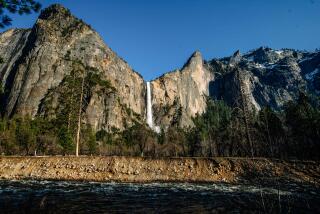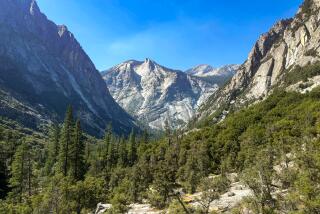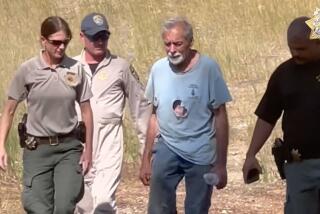Kings Canyon Searchers End Hunt for Ranger
- Share via
FRESNO — After two weeks of probing the rugged high country below Mt. Whitney, Kings Canyon National Park search teams have failed to turn up a single clue to the whereabouts of ranger Randy Morgenson, and on Monday afternoon they reluctantly called off their active hunt.
Park supervisor Randy Coffman, who headed the intensive search for the popular summer ranger who worked under his watch, said it was one of the hardest calls he has ever made.
“It’s a mystery, a real mystery,” Coffman said. “Sometimes I think I’m going to wake up and it’s all a terrible dream and Randy’s out at his ranger’s station near Bench Lake and nothing has changed.”
High country rangers working their normal duties will continue to look for signs of Morgenson, a 54-year-old with longish hair and a mountain-man beard. Fliers with his photo and description have been posted at key points along the John Muir Trail. Hikers receiving permits will be asked to keep a watchful eye.
A photographer by profession, Morgenson spent 28 summers canvassing the treacherous but breathtaking High Sierra trails of Sequoia and Kings Canyon national parks. On July 20, he tacked a note to the door of his tiny cabin: “I’m going on patrol. Back on the 24th.” It was the last anyone has heard from him.
The treeless high country above Bench Lake is strewn with granite boulders that can sometimes become loose. Park officials speculate that Morgenson may have taken a wrong step and suffered a fatal head injury or become pinned under a rock and died of exposure or dehydration.
“That part of the park offers two possibilities,” said Arnold Gaffrey, a Pasadena insurance agent who led a search and rescue team from Sierra Madre. “There are boulder fields where you can be in danger and flat places where you can camp in safety.
“I hate to hazard a guess, but obviously he’s in there somewhere and it’s unlikely he’s still alive.”
It has been nearly 20 years since the disappearance of a national park ranger was cloaked in such mystery. In the late 1970s, Paul Fugate disappeared while patrolling a stretch of the Chiricahua National Monument in southeastern Arizona. His body was never found.
No foul play is suspected in the case of Morgenson. There was speculation that Morgenson’s disappearance was related to the recent breakup of his marriage, but Coffman seemed to discount that.
“I saw Randy the day before he went into the back country, and he was very anxious to get to work,” Coffman said. “One of the last people to see him said he seemed very upbeat. We can conjecture, but those are my last clues about Randy’s emotional state. And I have no reason to believe his mood had changed.”
Judy Morgenson, his estranged wife in Arizona, said she did not want to comment. “I’m dealing with a lot of things right now,” she said, her voice breaking. “I’m having a hard time. I’m in limbo and it’s still too fresh.”
On Monday morning, two rangers searched one last area--Knapsack Pass, about 10 miles from Bench Lake--before the active search was called off. At its height, more than 60 searchers from around the state--many of them rangers from other parks--responded to the call.
It was a search made more problematic by the fact that Morgenson knew many of the mountain’s nooks and crannies, any one of which could have betrayed him. “We had five or six people who hiked with him a lot, and they knew his favorite spots and his style of camping,” said searcher Gaffrey.
“But even with this knowledge, Randy had the ability to wander off in a lot of different directions. So his travel pattern could be very much like a lost person’s.”
Five helicopters ferried teams of searchers to the treacherous granite bowls and scarps at the 11,000-foot elevation. The helicopters then canvassed from the air while seven dog teams sniffed at the ground.
At the end of each day, searchers were debriefed on the terrain they covered and the probability that their area still could be hiding Morgenson. The information was fed into a computer program that calculated when each area had been sufficiently canvassed and targeted the next likely area for search.
“A lot of the rangers were emotionally involved because Randy was one of their own,” Gaffrey said. “Volunteers like us go up with the idea you can help, and its always hard to come back without a definitive answer. There’s a lot of head scratching.”
More to Read
Sign up for The Wild
We’ll help you find the best places to hike, bike and run, as well as the perfect silent spots for meditation and yoga.
You may occasionally receive promotional content from the Los Angeles Times.






